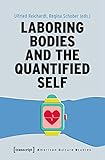Laboring Bodies and the Quantified Self / ed. by Regina Schober, Ulfried Reichardt.
Material type: TextSeries: American Culture Studies ; 27Publisher: Bielefeld : transcript Verlag, [2020]Copyright date: ©2020Description: 1 online resource (246 p.)Content type:
TextSeries: American Culture Studies ; 27Publisher: Bielefeld : transcript Verlag, [2020]Copyright date: ©2020Description: 1 online resource (246 p.)Content type: - 9783839449219
- American literature--History and criticism
- Human body in literature
- Human body--Social aspects--United States
- Labor in literature
- Labor--Social aspects--United States
- Self-actualization (Psychology) in literature
- Self-actualization (Psychology)
- Self-monitoring--Social aspects--United States
- America
- American Studies
- Biopolitics
- Body
- Cultural Studies
- David Foster Wallace
- Fertility
- Herman Melville
- Labor
- Literary Studies
- Literature
- Postfeminism
- Subjectivity
- US Fiction
- LITERARY CRITICISM / American / General
- America
- American Studies
- Biopolitics
- Body
- Cultural Studies
- David Foster Wallace
- Fertility
- Herman Melville
- Labor
- Literary Studies
- Literature
- Postfeminism
- Subjectivity
- US Fiction
- 810.93561 23/ger/20230216
- online - DeGruyter
| Item type | Current library | Call number | URL | Status | Notes | Barcode | |
|---|---|---|---|---|---|---|---|
 eBook
eBook
|
Biblioteca "Angelicum" Pont. Univ. S.Tommaso d'Aquino Nuvola online | online - DeGruyter (Browse shelf(Opens below)) | Online access | Not for loan (Accesso limitato) | Accesso per gli utenti autorizzati / Access for authorized users | (dgr)9783839449219 |
Frontmatter -- Contents -- Introduction: Laboring Bodies and the Quantified Self -- Command and Control: The Quantified Self and Biomedical Transhumanism -- Reconsidering Agency and Choice: The Office, the Wall, and the Tax Code (Herman Melville, “Bartleby” and David Foster Wallace, The Pale King) -- “To Be Reckoned in the Gross”: Corporate Storytelling and Quantified Selves in Joshua Ferris’s Then We Came to the End -- Racialized Self-Improvement: Advice in Black and White Self-Help of the Interwar Years -- The Solipsism of the Quantified Self: Working Bodies in David Foster Wallace’s Body of Work -- Reading Chick Lit through Numbers: Postfeminist Self-Quantification in Helen Fielding’s Bridget Jones’s Diary and Karyn Bosnak’s What’s Your Number? -- “I Track my Cycle Religiously”: Representations of Fertility Tracking and Childlessness in Contemporary Graphic Memoirs -- Compulsive Self-Tracking: When Quantifying the Body Becomes an Addiction -- The Portable Peoplemeter Initiative: Wearable Sensor Technologies and Embodied Labor -- Instant Nerve-Ana: Biofeedback as Quantified Self Avant la Lettre -- Contributors
restricted access online access with authorization star
http://purl.org/coar/access_right/c_16ec
The body has become central to practices of self-tracking. By focusing on the relations between quantification, the body, and labor, this volume sheds light on the ways in which discourses on data collection and versions of the ›corporate self‹ are instrumental in redefining concepts of labor, including notions of immaterial and free labor in an increasingly virtual work environment. The contributions explore the functions of quantification in conceptualizing the body as a laboring body and examine how quantification contributes to disciplining the body. By doing so, they also inquire how practices of self-tracking, self-monitoring, and self-optimization have evolved historically.
Mode of access: Internet via World Wide Web.
In English.
Description based on online resource; title from PDF title page (publisher's Web site, viewed 25. Jun 2024)


